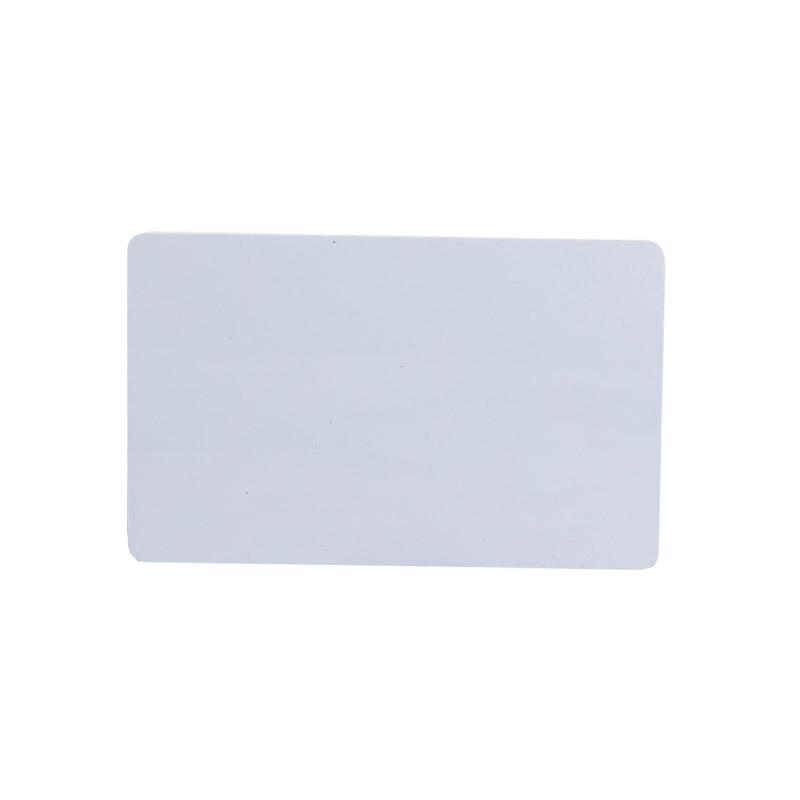کارت Radio-frequency identification که به اختصار RFID نامیده می شود وسیله ای برای شناسایی و کنترل افراد در کارخانه ها، شرکت ها، سمینارها، کارت های هوشمند، سیستمهای کنترل، بخش کنترل چمدان ها و کتابخانه ها می باشد. این کارت های شناسایی دارای یک مدار الکترونیکی می باشند که شامل آنتن و تراشه است. تراشه داخل کارت RFID دقیقا کارکردی مشابه بارکدها یا نوارهای مغناطیسی دارد و درست مانند آنها برای گرفتن اطلاعات نیاز به اسکن شدن دارد که به منظور کدگذاری و خواندن اطلاعات از تراشه ها استفاده می گردد.
کارت های RFID غیر تماسی هستند و برای اسکن شدن نیازی به تماس دقیق با اسکنرها ندارند و زمانی که تگ نزدیک یا در محدوده کدخوان (RFID Reader) قرار می گیرد میدان مغناطیسی تولید شده توسط کد خوان، باعث فعال شدن تگ می گردد و کارت به طور پیوسته اقدام به ارسال داده از طریق پالس های رادیویی می کند و در نهایت داده توسط Reader دریافت و توسط کامپیوتر، میکروکنترلر و یا پردازنده های دیگر پردازش و ارسال می شود.
سطح این کارت آر اف آی دی فرکانس 13.56 مگاهرتز قابل چاپ بوده و شما می توانید طرح خود را با استفاده از چاپگرهای ویژه بر روی آنها پرینت نمایید. برای خرید دستگاه کارتخوان این تگ ها با فرکانس 13.56 مگاهرتز می توانید به این بخش مراجعه نمایید. همچنین برای ذخیره اطلاعات بر روی حافظه این کارت می توانید از این ماژول استفاده نمایید.
Radio-frequency identification (RFID) uses electromagnetic fields to automatically identify and track tags attached to objects. The tags contain electronically stored information. Passive tags collect energy from a nearby RFID reader's interrogating radio waves. Active tags have a local power source (such as a battery) and may operate hundreds of meters from the RFID reader. Unlike a barcode, the tags don't need to be within the line of sight of the reader, so it may be embedded in the tracked object. RFID is one method of automatic identification and data capture.
Within the Electromagnetic Spectrum, there are three primary frequency ranges used for RFID transmissions – Low Frequency, High Frequency, and Ultra-High Frequency.
RFID tags can be either passive, active or battery-assisted passive. An active tag has an on-board battery and periodically transmits its ID signal. A battery-assisted passive (BAP) has a small battery on board and is activated when in the presence of an RFID reader.
A passive tag is cheaper and smaller because it has no battery; instead, the tag uses the radio energy transmitted by the reader.
RFID tags contain at least three parts: an integrated circuit that stores and processes information and that modulates and demodulates radio-frequency (RF) signals; a means of collecting DC power from the incident reader signal; and an antenna for receiving and transmitting the signal.
The tag information is stored in non-volatile memory. The RFID tag includes either fixed or programmable logic for processing the transmission and sensor data, respectively.
The European Telecommunications Standards Institute (ETSI) is the governing body in Europe that sets and upholds country-wide standards for communicating via multiple channels, including Radio Waves.
By ETSI’s regulations, RFID equipment and tags are only allowed to communicate on the smaller frequency range of 865 - 868 MHz because other types of radio communications are allocated to subsets of the larger range of 860 - 960 MHz.
Because ETSI sets the standards for Europe, but when purchasing tags and equipment, the standard can be called either ETSI or EU denoting Europe.
What sets a potential RFID application apart from applications that can use other types of systems is the need to uniquely identify individual items quickly and more efficiently where traditional systems fall short. Below are a few applications that are successfully using RFID technology.
Access management, Tracking of goods, Tracking of persons and animals, Toll collection and contactless payment, Machine-readable travel documents, Smartdust (for massively distributed sensor networks), Airport baggage tracking logistics, Timing sporting events, Tracking and billing processes
Features:
01. Capacity: 8K-bit EEPROM
02. Photo detection is divided into 16 sectors, each sector is 4 blocks, every 16 bytes to block access unit
03. Each Photo detection sector has a separate a set of passwords and access control
04. Each card has a unique serial number, as 32
05. Have an anti-collision mechanism supports Reader's Multiple Card Operation
06. No power comes with antenna, includes encryption control logic and communication logic circuit
07. Data retention period of 10 years, can be rewritten 100,000 times, read unlimited
08. Operating temperature: -20 ℃ ~ 50 ℃ (temperature of 90%)
09. Operating frequency: 13.56MHZ
10. Communication rate: 106Kbps
11. Detection distance: 10mm or less (and reader related)



